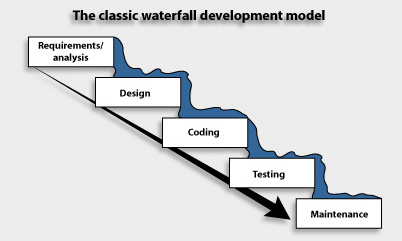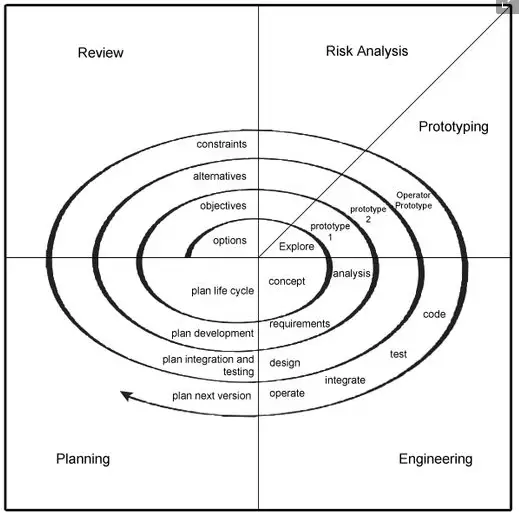The Software Development Process is the structured approach to developing software for a system or project, sometimes called the Software Development Life Cycle (SDLC). Several approaches can be used, including waterfall, spiral, Agile, and incremental development. These different approaches will focus the testing effort at different points in the development process. However, each approach is composed of the same basic steps of development. The incremental development approach typically forms the basis for software development within the larger systems level of Evolutionary Acquisition (EA). [1,2]
Definition: A software development process is a way to improve design and product management by breaking software development work into smaller steps or sub-processes that can be done in parallel or in-order.
Types of Software Development Approaches
The Software Development Approaches below show how the various tasks related to software development can be organized. Typical approaches or paradigms encountered in software development include waterfall, incremental, and spiral as described below. The incremental development approach typically forms the basis for software development within the larger systems level of Evolutionary Acquisition (EA). There are four main types of software development approaches which are:
- Waterfall Approach
- Incremental Approach
- Spiral Approach
- Agile (Scrum)
Waterfall Approach
Development activities are performed in order, with possibly minor overlap, but with little or no iteration between activities. User needs are determined, requirements are defined, and the full system is designed, built, and tested for ultimate delivery at one point in time. A document-driven approach best suited for highly precedence systems with stable requirements.
The waterfall model is often also referred to as the linear and sequential model, for the flow of activities in this model are rather linear and sequential as the name suggests. In this model, the software development activities move to the next phase only after the activities in the current phase are over. However, as is the case with a waterfall, one cannot return to the previous stage.

Incremental Approach
Determines user needs and defines the overall architecture, but then delivers the system in a series of increments
(“software builds”). The first build incorporates a part of the total planned capabilities, the next build adds more capabilities, and so on, until the entire system is complete.
Spiral Approach
A risk-driven controlled prototyping approach that develops prototypes early in the development process to specifically address risk areas followed by an assessment of prototyping results and further determination of risk areas to prototype. Areas that are prototyped frequently include user requirements and algorithm performance. Prototyping continues until high-risk areas are resolved and mitigated to an acceptable level.
During each iteration or loop, the system is explored at greater depth, and more detail is added. Appropriate for exploratory projects working in an unfamiliar domain or with unproven technical approaches. The iterative nature allows for knowledge gained during early passes to inform subsequent passes. Requires low up-front commitment.

Agile and Scrum Approach
The Agile software development process and its most popular method, Scrum, use a dynamic and iterative way to build software. In contrast to the strict, sequential flow of the Waterfall process, cross-functional teams in Agile work in “Sprints” of a week or a few months to build and release software that customers can use and give feedback on. Agile is all about moving quickly, putting out new versions often, and responding to what your users really need, even if that goes against what you had planned. This means you don’t need a full list of requirements and a full SOW before starting work. Instead, you move in one direction with the idea that you will change directions along the way.
Software Development Process Metrics
Software metrics should be an integral part of the software development processes. Program Management Offices (PMO) should gain insight into proposed metrics during source selection, and developers should commit to the consistent use of those metrics, including collecting, analyzing, and reporting. Metrics chosen for use should be defined in the Software Development Plan (SDP). Software metrics should: [1]
- Be integral to the developer‘s processes.
- Clearly portray variances between planned and actual performance.
- Provide early detection or prediction of situations that require management attention.
- Support the assessment of the impact of proposed changes on the program.
Choosing the Correct Software Development Approach
Software engineers should take into account several variables when choosing a software development approach for a project to ensure the greatest fit for their unique requirements. Here are some tips for assessing and choosing the best strategy from among the several possibilities, including waterfall, incremental, spiral, and agile:
- Project Requirements: Recognize the type of requirements for the project. A more sequential method, like the waterfall model, might be effective if the requirements are clearly specified and unlikely to change dramatically. Conversely, Agile approaches may be more suited if the requirements are flexible and likely to change.
- Project Size and Complexity: Consider the project’s size and complexity. A more conventional strategy like the waterfall model may be adequate for smaller projects with unambiguous goals. However, methodologies that support iterative development and ongoing feedback, like incremental or agile approaches, typically perform better for larger and more complicated projects.
- Flexibility and Adaptation: Throughout the development process, evaluate the need for flexibility and adaptability. Agile approaches are excellent when requirements are likely to change because they strongly emphasize numerous iterations, ongoing feedback, and adaptability. Iterative cycles for risk management are incorporated into the spiral model, which also offers flexibility.
- Timing Restrictions: Consider the project’s timing restrictions. A more linear strategy, such as the waterfall model, may be effective if there is a hard deadline and it is unlikely that the requirements would change dramatically. However, agile or incremental approaches that emphasize providing usable software in brief iterations might be helpful if time-to-market is important or if the project calls for frequent releases.
- Stakeholder Involvement: Take into account the degree of collaboration and stakeholder involvement needed. With frequent communication and feedback loops, agile techniques encourage active stakeholder involvement throughout development. Agile approaches are suitable if stakeholder collaboration is essential for the project’s success.
- Risk Management: Assess the project’s need for risk management. The spiral model, which combines risk analysis and mitigation at each iteration, is beneficial when working with high-risk projects. Risk management strategies used by other approaches, such as agile, include constant feedback and early problem detection.
- Team Experience and Skill Set: Evaluate the development team’s experience and skill set. Continuing with a methodology could be more effective if the team has past experience and skill with it. Agile methodologies, which encourage cooperation and continuous improvement, are worth considering if the team is receptive to adopting new methodologies.
- Client or Industry Requirements: Consider any unique demands or tastes of the client or sector. Some clients or industries may have established preferences for specific development methodologies. To guarantee client happiness and compliance, aligning with these requirements is crucial.
Remember that these strategies are not mutually exclusive and that hybrid models can be adjusted to meet the needs of specific projects. The key is to assess the project’s characteristics, goals, and restrictions while considering the team’s capabilities and stakeholder expectations when choosing a strategy.
AcqLinks and References:
- USAF Weapon Systems Software Management Guidebook – 15 Aug 2008
- Mil-STD-498 “Software Development and Documentation” – 5 Dec 1994
- MIL-STD-498 “Application and Reference Guidebook” – 3 Jan 1996
- Software Development Plan Information Outline
- Template: Software Development Plan – SPAWAR
Updated: 7/11/2023
Rank: G4.8

